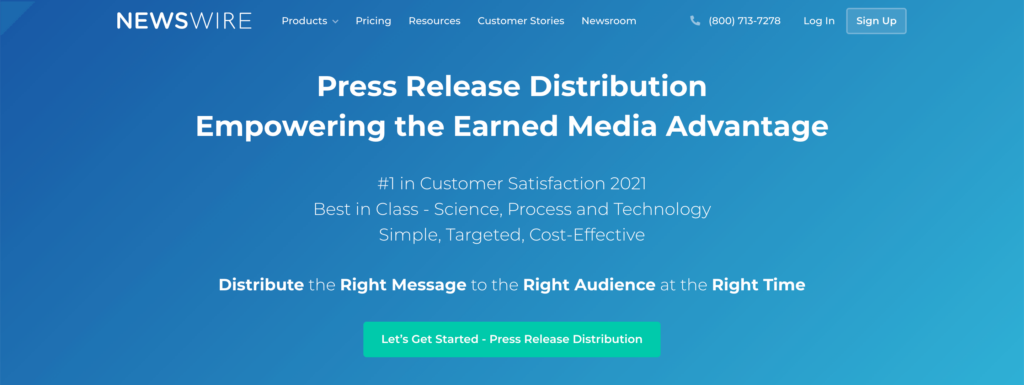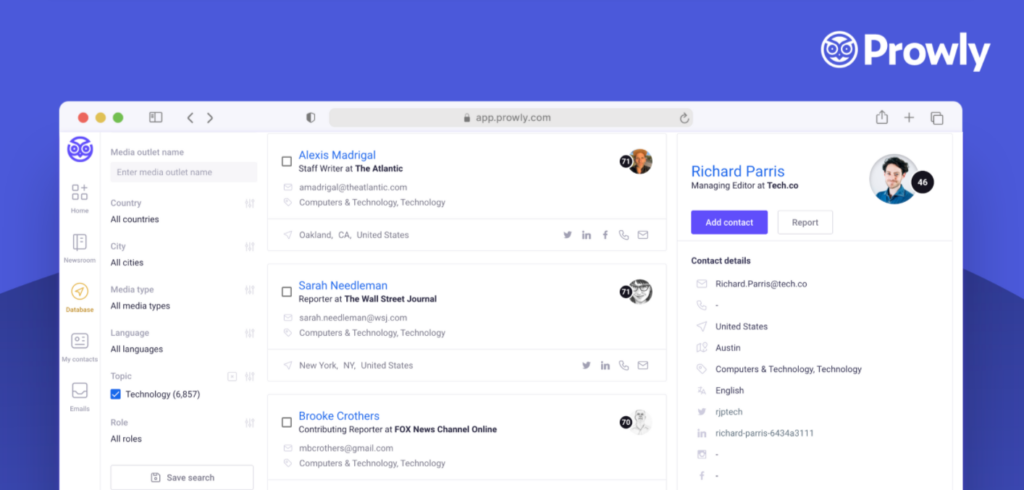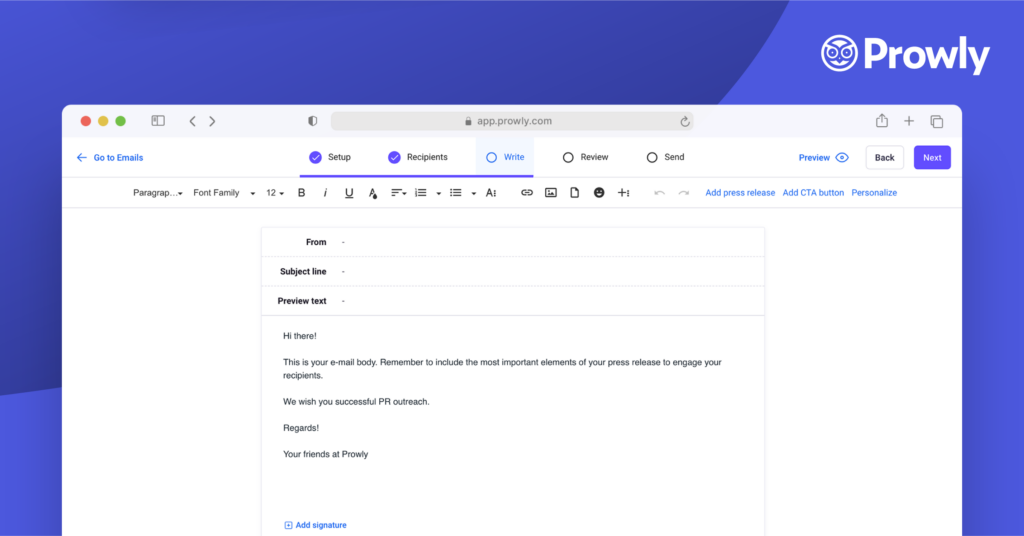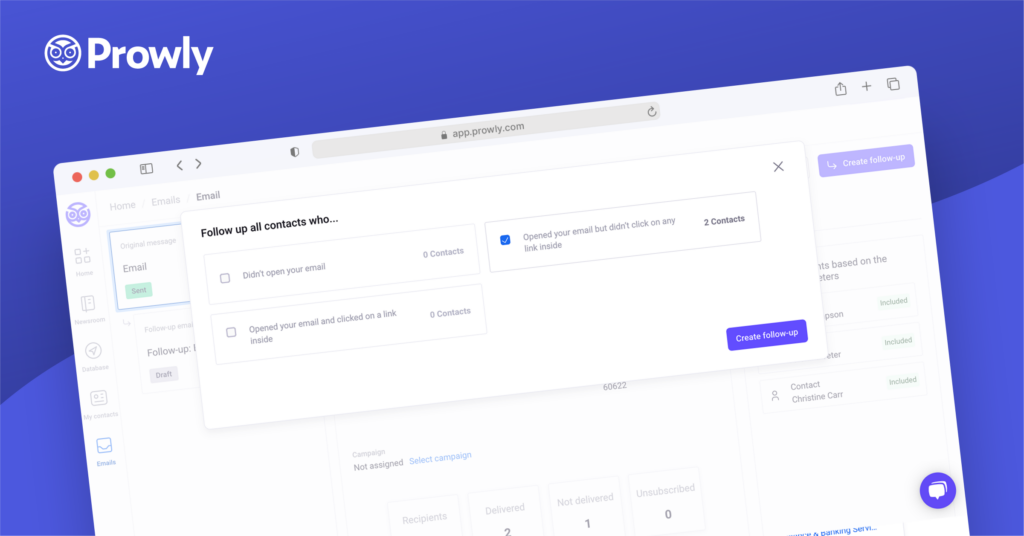Press release distribution services are tools that allow you to send press releases to a large, targeted audience of journalists, social networks, bloggers, influencers, and traditional or digital media outlets, either automatically or manually.
There are two main types of press release distribution services automated press release distribution services (often referred to as newswire or just “wires”) and manual press release distribution services that give you the tools to effectively pitch your story to the media by yourself via PR outreach.
Usually, people have the first one in mind when they hear “press release distribution”. Both have their pros and cons, but the general consensus among PR experts is that media outreach—although more time-consuming—is the way to go if you want better results.
Nonetheless, wire services have their purpose and remain a long-standing and popular choice for press release distribution. This guide covers how to choose the right distribution model and the best press release distribution service for your needs:
- Choosing the best distribution method
- Choosing the best press release distribution service (newswire)
- Choosing the best PR outreach tool
Choosing the best method for distributing your press release
First of all, why bother distributing a press release?
Press releases are a great way to get media coverage; in turn, this lets you increase exposure for your brand and reach new audiences. Plus, it’s cost-effective compared to paying for advertising.
Secondly, should you use press release distribution services?
If you specifically have “wire” services in mind—it depends. For example, if you're a publicly listed company, presswires will clearly be of value for you.
Still, if you’re thinking about any kind of press release distribution software or services, including PR outreach tools, then you definitely should.
Here’s why. If you want to distribute a press release by yourself (and get results), you have to go through the whole process of finding media contacts, creating a media list, pitching them, following up, and potentially building media relations with said people.
As an example, Medstar helped a social campaign land 150 publications and go viral by using Prowly, a PR outreach tool. Could they have done it by themselves? Maybe. However, it would take hours upon hours of creating a media list and reaching out to journalists manually to get the same kind of results.
So the question is not if you should use press release distribution services, but rather finding the one best suited for your needs.
Newswire press release distribution vs PR outreach overview
| Newswires | PR outreach | |
| Pros | – Quick – Usually wider reach – Simple – Does not require finding media contacts | – Personalized distribution – More effective – More control |
| Cons | – Usually ineffective – Expensive | – Can be time consuming |
Newswires
Newswires like PR Newswire, PRWeb, and Ein Newswire are services that distribute your press releases. They work by sending press releases to subscribing news organizations, newspapers, and outlets such as Associated Press, Bloomberg, CNBC, CNN, the Wall Street Journal, and Yahoo! Finance and news sites such as Google News, Bing, or Yahoo.
Professionals working in the PR industry have mixed opinions about press release distribution services and their effectiveness.
Presswires are not about success stories anymore — these are just mechanisms of delivering the news to a broad network of news websites. You pay for the result and in this sense, this doesn't really qualify as a success. - Joanna Drabent, CEO @ Prowly
Jas from Vitis PR conducted a study based on 80 journalists from the UK and what they think about newswires. Here’s what one had to say:
Journalists do use wires, but it seems that they are used more for checking facts than picking up new stories. We believe that the best way to target a journalist is to follow them, understand what they write about, pitch a story to them exclusively, and provide them with good content.
The general consensus of journalists from the study was that wires offer the ability to provide additional information, however, newswires need to find a way to help cut through the endless amount of less valuable press releases.
Relevance is a major issue—many journalists do not want to wade through newswires that are filled with irrelevant or investor-type releases.
On the other hand, Jas noted that focused newswire services are clearly valuable for some sectors, such as automotive.
Nonetheless, the study showed that 37% of journalists use a newswire every day, and 30% use one occasionally. If you add up those numbers, it turns out that 2/3 of journalists use a newswire—a considerable amount.
Manual press release services
On the other hand, there's "manual" PR outreach that involves reaching out to relevant journalists and other media contacts via dedicated tools, in order to pitch them your story or press release.
The benefit of such tools is that they greatly simplify the process of doing manually, which considerably takes up a lot more time and effort.
Finding relevant contacts for your news—whether it’s by beat or location—is a breeze with the included media database (or smart contact recommendations based on the contents of your press release offered by Prowly).
As for the actual distribution, it’s a big improvement versus doing it manually by yourself. Personalization features, high deliverability, and effective follow-ups let you get your press release out to many relevant journalists at once.
The downside compared to newswires, is that the process can still take a bit longer and their reach is smaller (but more targeted).
Which press release distribution method should you choose?
Both methods have their purpose for PR distribution. Figure out which one is better for your industry. Or if you have the time—try both.
You might find that some are better at trade or B2B media, yet others outperform for mainstream and B2C news.
And remember—the success of your distribution and chances of getting media coverage ultimately rely on the story you have. Make sure it’s actually newsworthy and interesting.
What to consider when choosing a press release distribution service (newswire)
It’s difficult to answer the question, “which is the best press release distribution service?” because it depends on your industry and your business needs.
As vague as it sounds, using what worked for someone else doesn't mean if it'll work for you.
Here are the main things to consider when choosing a provider and prepared a list of the most popular newswires to help you make the right choice.
- Pricing
- List of outlets
- Your intended audience
- Extra features
- Support
- Reporting
- Search visibility
- User experience
Pricing
Pricing is one of the most important factors, so let’s cover it first.
How much does it cost to release a press release? Depending on the provider, this can be anywhere from $0 to thousands of dollars.
For example, sending a press release with PR Newswire, one of the most popular options available, starts at $500-600 for the most basic option (read more in the PR Newswire pricing guide).

What’s worth noting—there’s rarely one single price. The cost of distributing a press release will vary greatly depending on the geographical scope of the distribution, add-ons, and extra features.
That’s why besides the actual price, what is crucial—if not more so—is choosing a provider with an easy-to-understand pricing plan.
With many providers charging extra for almost any add-on you can think of, it’s important to be able to understand how much you can expect to pay in the end, without any unpleasant surprises.
There are also cheap or even free press release distribution services. But generally, you get what you pay for, so keep that in mind.
List of outlets
How many media outlets does the wire cover? This includes news websites, aggregators, media outlets, and news content systems. This will also depend on the pricing plan or geographical scope that you select. More is not always better, although it can increase your chances of getting coverage.
Additionally, many providers offer guaranteed placements, including all the major news sites—Google News, Yahoo, and Bing.
Intended audience
Who should receive your press release? An easy way to segment your audience is by the following:
- Local, regional, and national markets
- Multicultural markets (e.g. African-American audiences)
- Specific industries (e.g. automotive)
- International (e.g. European audiences)
Based on who you're trying to reach, find out what the targeting options are for the service you're planning on using.
Additional features
What kind of features and additional services are available for distributing your press release? These can include:
- Customizable, interactive content
- Being able to add multimedia to your press release
- Additional services
Usually, these features will be priced extra, but it's worth looking into them if it makes sense for your business. For example, if you're writing a press release about a product, choose a provider that allows you to showcase the product in the press release with photos or videos.
Support
Does the provider have a strong customer support team? Look through reviews or ask people that used the service.
Support can include proofreading and editorial support (usually priced extra) or general support related to using the platform.
And finally, how responsive is support, and are they available 24/7?
Reporting
What kind of reporting does the provider offer? You want a service that can help you measure the success of your brand’s content promotion and press release distribution efforts.
Reporting should be part of the package, and provide you with actionable information and metrics to gain insights on the effectiveness.
Additionally, you should be able to see where your content appeared online, how many views it received and what organizations are interested.
Search visibility
One of the possible benefits of press release distribution is SEO visibility, although many professionals dispute its effectiveness. If this is important for you, look for a service with strong domain authority. It’ll increase the possibility of appearing on Google in front of your target audience.
User experience (ease of use)
Last, but not least, choose a tool that’s secure & easy to use, especially if you’re going to be distributing press releases often. If possible, give the platforms a try yourself, or pay attention to what reviewers are saying.
Look for a newswire that has a proven record of accomplishment with the media and has a history of being a source of valuable news and information.
Examples of press release distribution services
- EIN Presswire
- PR Newswire
- Newswire
- BusinessWire
- 24-7pressrelease.com
- PR Underground
- NewswireJet
- Send2Press

What to consider when choosing a PR outreach tool
If you decide to go for a PR outreach tool instead, the final choice will depend on a couple of things (mainly if you already have your own media list).
- Media database
- Pricing
- Contact management (exclusions)
- Personalization
- Email creator (visual editor)
- Deliverability
- Follow-up
- Press release creator
- Integration with other tools
Media database
Does the provider have an available media database? After all, you should be pitching your story to relevant media contacts. It’s OK if you already have your own media contacts or are using a different provider, but it makes things simpler if everything is integrated and in one place.

With Prowly, you can not only access a Media Database with over a million contacts but also use AI smart recommendations based on the content of your press releases. This way, you'll always pitch relevant journalists that are likely to be interested in your story.
For example, Prowly's Media Database currently boasts 1,819 contacts to journalists who cover book-related press releases—and this is just in the U.S. This means there's a high chance of news coverage.
Pricing
Pricing-wise, it’s worth looking into a few things. Look into how much you have to pay and what features are included. Secondly, check the contract type. Can you purchase a monthly plan, or do you have to pay upfront for a whole year?
For example, Prowly offers monthly and annual plans starting at $258/mo, while the cost of Cision can go up to thousands of dollars.
Free trial
One of the most important things is to be able to try out the service by yourself before you have to take out your wallet.
Look for services that let you explore the interface and see if everything you need is there and it’s easy to use.
Take this time to chat with customer support. Are they responsive and helpful? And finally—if possible—give the platform an actual test drive. Import or create a media list and reach out to journalists (or your co-workers) with your story.
Prowly offers a free 7-day trial with media database search access, no CC required.
Contact management (exclusions)
Look for a service that lets you easily manage your media contacts. It’s basically an upgraded version of Excel that you would use to store your contacts. They include tags, filters, and other features to keep you organized and let you collaborate with your team.
Take note if there are flexible and easy-to-use targeting options for selecting people for your distribution. With PR outreach, it’s important to get your message to the right journalists, editors, and bloggers so you need something that’ll let you stay in control of the whole process.
Personalization
PR outreach works partially because it’s personalized and you’re reaching out to relevant media contacts. You could send each person on your list a custom email, but that would take ages.
Personalization options let you keep your messages targeted while saving a lot of time. These can include the basic personalization tokens like {first name} or it can involve being able to easily segment your media lists into smaller groups and send each targeted message.
Email creator (visual editor)
With all the emails and press releases journalists receive, it’s not easy to get their attention. It can help if you spruce up your emails (without overdoing it) by adding visuals and other multimedia. This can be done with Outlook, but having a dedicated email creator for PR outreach can make things easier.

You can also write an entire email, including a captivating title, using Prowly's AI.
Deliverability
Deliverability can be defined by the percentage of emails that actually make it to the people you’re pitching. This can be understood not only by having up-to-date email addresses from the media database, but also if the emails avoid the dreaded spam folder.
While it might be difficult to actually measure and compare a PR outreach tool’s deliverability, it’s something worth asking about.
Follow-up
Following up is a crucial part of the outreach process, but it can be a bit awkward if you’re sending out the third email to somebody and you don’t even know if they received your press release.
Look for a tool that lets you see which contacts received, opened, or clicked on a link in your email. Additionally, it should let you filter and segment contacts easily so you can easily send a follow-up to the right people.

Integration with other tools
It’s not a must, but it can help if the outreach tool you choose has other PR tools available.
These can include a press release creator that lets you present your story in a visual way, media monitoring tools to see where you’re getting coverage, or online newsrooms that let you display your company news in one place and effectively tell your brand story.
Examples of PR outreach tools
- Prowly
- Prezly
- Muck Rack
- JustReachOut
- AgilityPR
Conclusion
Press releases are an effective way to get coverage for your company. It’s worth putting in the effort to figure out which press release distribution service is best for your business.
Write down what’s important for you and narrow your search down to a few options. Give them a try and see which one works best.
If you’re short on time and don’t want to speak with sales, start off with something that offers a free trial, like Prowly, and see what you like and don’t like about press release distribution services.
Cover photo by Brooke Cagle

